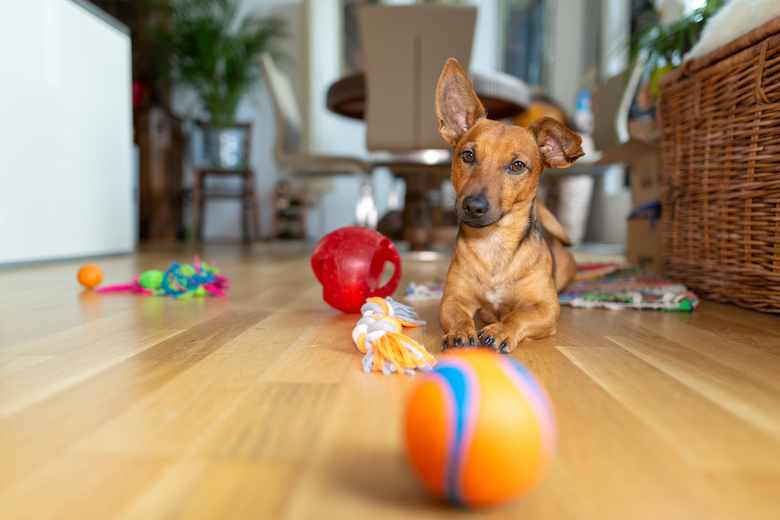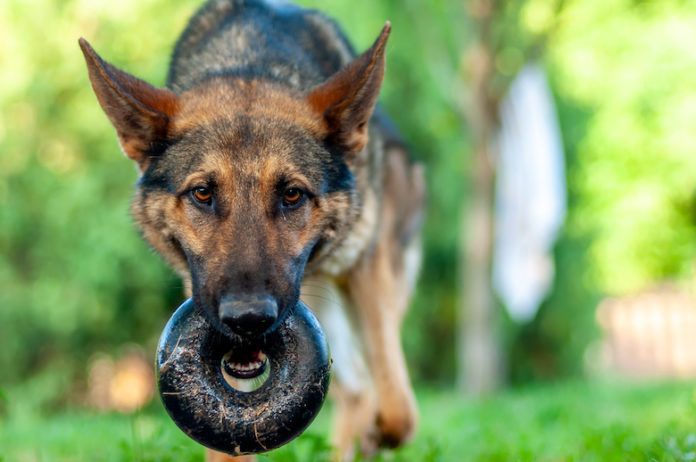We all want to keep possession of our valuable stuff. It’s why we lock our doors, and why some people keep weapons. Dogs (and other animals) are no different – many dogs are reluctant to give up a valuable object, whether it’s a favorite toy, a raw meaty bone, a tasty piece of cat poop from the garden or your bedroom slipper.
Some dogs guard their valuables fiercely enough to hurt anyone who tries to take them away. We call this “resource guarding.” It’s a natural, normal behavior. Keeping possession of valuables is an important survival skill – if you let someone take your food from you in the wild, you’re likely to die.
Related: What Is Resource-Guarding And What Should You Do About It
Still, we sometimes need to take things away from our dogs. Cat poop is gross, and your slipper is valuable to you, so it’s nice to be able to remove those from his jaws. Even more important, if your dog has something harmful – a cooked chicken bone or a package of rat poison, you have to be able to take it away.
While some dogs allow you to forcibly remove stuff from their mouths, many will get more aggressive the more aggressively you try to take something away. As in all things canine, we are far better off convincing our dogs to be cooperative partners than trying to coerce them into doing what we want.

The Trade Game
In teaching “Trade,” you promise your dog something of value in exchange for the valuable (in his eyes) item he has in his mouth. (Cat poo may not be valuable to humans, but it is of incredibly high value to many canines!). Here’s how to teach it:
1. Say “Take it!” and give your dog a low-value object – something he’ll easily give up in exchange for a high-value treat. (You might tether him to something solid so he can’t run off with the item.)
2. Let him sniff your high-value treat, but don’t try to push it into his mouth. (Anything resembling coercion will likely increase his resistance.) Don’t use your cue yet! Have a large handful of high-value treat-bits.
3. If he drops the item, click your clicker (or use some other marker). While he nibbles at the treats in your hand, pick up the object with your other hand and hide it behind your back. You must use two hands!!! If you let him eat the high-value treats and then race him back to the object you’re likely to lose the race and elicit resource guarding.
4. As soon as the treats are gone, bring the object out from behind your back, say “Take it!” and give it to him. This teaches him that he doesn’t always lose the object – he trades with you and gets it right back. This will make him more willing to trade with you again in the future; it’s a win/win for him!
5. If he doesn’t drop the item, make a “Hansel and Gretel” trail of treats under his nose, trailing a foot or so off to the side. Engage his mouth with the treats in your hand after he follows the trail, and pick up the item with your other hand.
6. If he still doesn’t drop the item, use a lower value item, and/or higher value trade-treats. (Meat, not dry cookies.) If he won’t show interest in the object after you’ve traded for high-value treats, use a higher value object, and/or lower value trade-treats.
7. When he’ll drop the item for your treats, say “Trade!” first, pause for a few seconds, then offer treats. Click when he drops the item, and pick up the item with your free hand while you keep him busy nibbling treats.
8. After several repetitions, sometimes pause a few seconds longer before offering treats. Your goal is to get him to drop the object when you say “Trade!” before you offer treats. When he’ll do this reliably, you have the behavior “on cue” – he drops the object because he understood the cue, not just because you stuck treats under his nose.
While ideally you’ll always have something in hand (or in pocket) to offer your dog in trade, if you train this well enough, in an emergency, even without treats to offer, your dog will still give up the poisonous mushroom in his mouth when he hears the “Trade!” cue. This works best if you remember to use your cheerful “training game” voice, not your “omigosh it’s an emergency” panic voice. Train “Trade” well… your training diligence could save your dog’s life.
Read Next: How to Prepare Your Dog for Being Left Home Alone







Thank you for this article, it was helpful and informative.